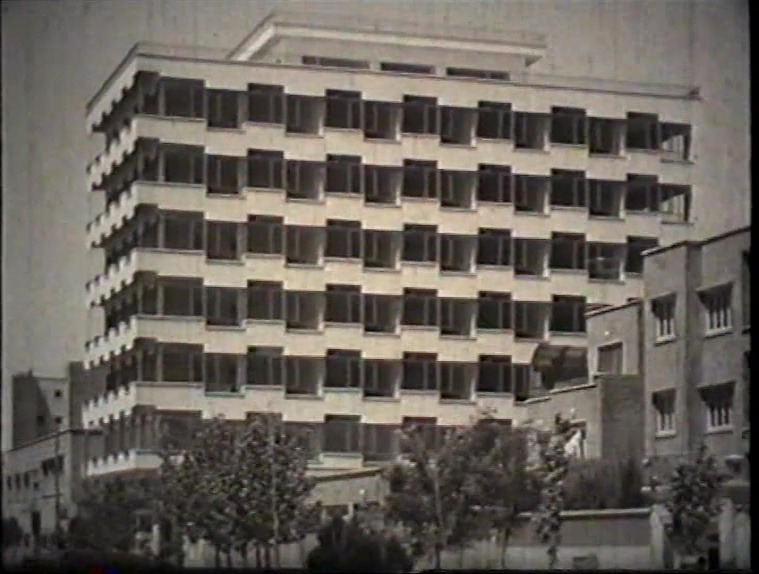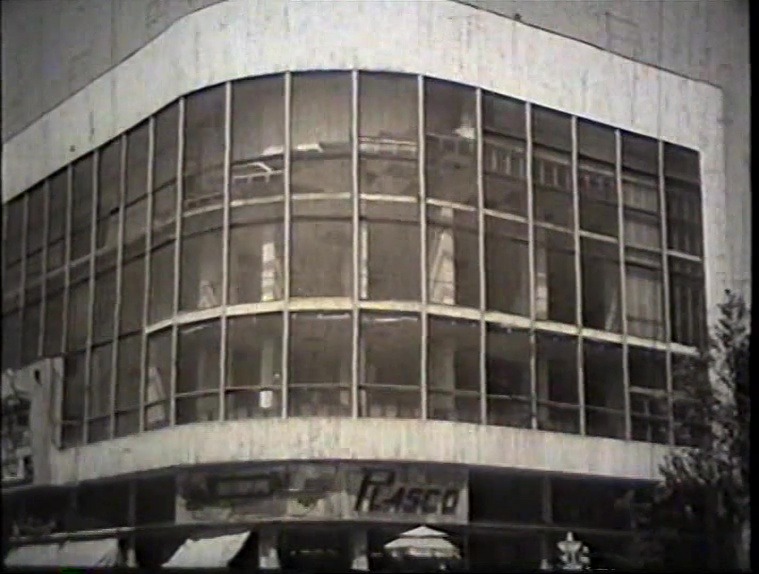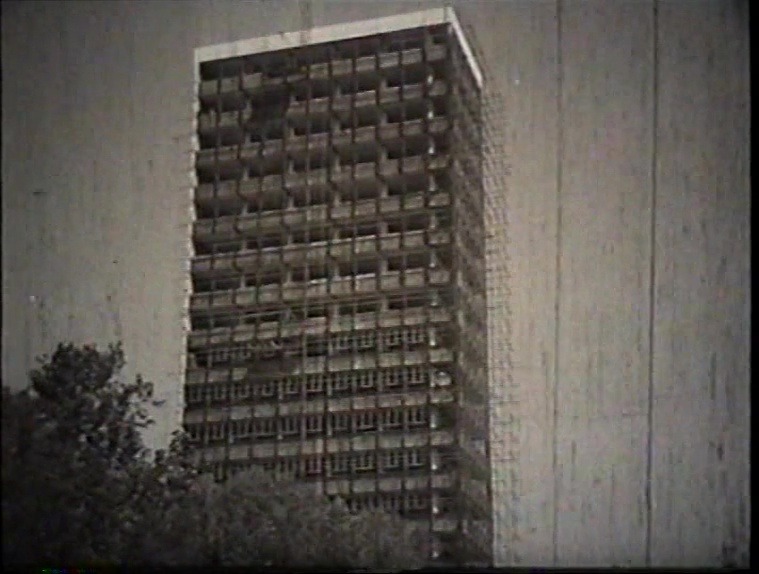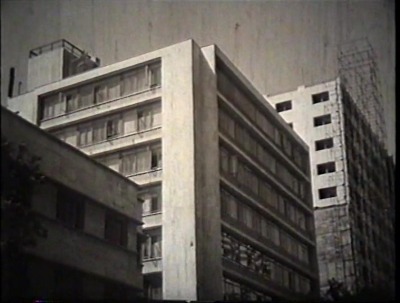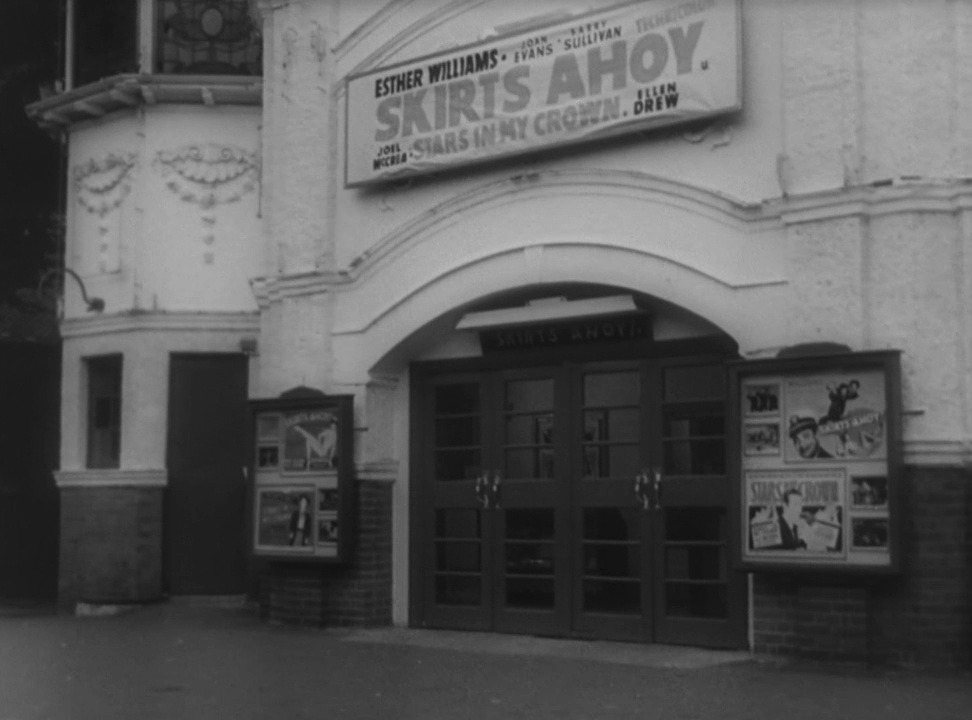“Murder didn't mean much to Raven. It was just a new job”. These lines open Graham Greene's novel about an assassin with a cleft lip who is hired to kill a government minister, only to find himself double-crossed by his contractor. Enraged, he seeks revenge while the police are on his tail. Proving adept at translating many of the book's details to the screen, Tuttle was also chiefly responsible for inventing cinema's angelic killer, in the way he reshaped the image of the disfigured Raven into a shiningly handsome yet darkly destructive messenger of death. (The action was also transferred from pre-war England to wartime California). Given unprecedented freedom, Tuttle wrote a treatment based on the book, which Paramount obtained upon publication in 1936 but had abandoned as unfilmable.
Wednesday, 9 February 2022
This Gun For Hire (Frank Tuttle, 1942)
“Murder didn't mean much to Raven. It was just a new job”. These lines open Graham Greene's novel about an assassin with a cleft lip who is hired to kill a government minister, only to find himself double-crossed by his contractor. Enraged, he seeks revenge while the police are on his tail. Proving adept at translating many of the book's details to the screen, Tuttle was also chiefly responsible for inventing cinema's angelic killer, in the way he reshaped the image of the disfigured Raven into a shiningly handsome yet darkly destructive messenger of death. (The action was also transferred from pre-war England to wartime California). Given unprecedented freedom, Tuttle wrote a treatment based on the book, which Paramount obtained upon publication in 1936 but had abandoned as unfilmable.
Saturday, 29 January 2022
Rivalry in the City
Tehran’s newly built modernist buildings shown during the title sequence of Reghabat dar Shahr [Rivalry in the City] (Uncredited, 1963)
This is the censored and re-edited version of Jonob-e Shahr [South of the City] (Farrokh Ghaffari, 1958)
Monday, 24 January 2022
Monogramming#2
 |
| Monogram Pictures, 1942 | 1725 Fleming Street in East Hollywood |
From an ad campaign, May 1942:
MONOGRAM'S 10th ANNIVERSARY
Promise vs. Performance
A promise is a sacred obligation. Monogram Pictures will not tolerate a promise unfulfilled.
A promise is only as good as the one who makes it. As men are judged by what they have done in the past, so we of Monogram Pictures, with a background of promises fulfilled, sincerely ask for your support in what we are offering for the season 1942-43.
We are young in years, but old in showmanship. We have approached the coming year with a determination to make this MONOGRAM'S GREATEST YEAR!
Thursday, 6 January 2022
Never on Sunday: Under Your Skin (Mikko Niskanen, 1966)
 |
| Under Your Skin |
NEVER ON SUNDAY is a series of screenings of rare classics, archive masterpieces, obscure delights and forgotten gems taking place the last Sunday of each month at Close-Up Cinema in east London. The first screening, on January 30, is dedicated to Mikko Niskanen's Under Your Skin. Tickets here.
Käpy selän alla [Under Your Skin]
Dir: Mikko Niskanen, 1966, 99 min, 35mm
Directed by Mikko Niskanen, an indispensable figure of Finnish new cinema of the 1960s, Under Your Skin is one of the most significant films in the history of Finnish cinema which, in the spirit of New Wave, embraces a whole new generation of Finns dreaming of "a universal sense of responsibility." (Peter von Bagh). The tender and real depiction of this new politically-conscious generation, as well as fresh cinematic ideas employed, were warmly welcomed by both the Finnish audiences (making the film the second box office hit of 1966) and the critics, the latter leading to the film winning six Jussi awards, the Finnish equivalent of the Oscar.
Thursday, 23 December 2021
Sixtynine (Jörn Donner, 1969)
 |
| Sixtynine (1969) |
As a part of tribute to Jörn Donner, Sixtynine plays (on 35mm) at London's Closeup Film Centre on January 14, 2021. - EK
When a working woman learns of her part-time hockey referee husband's infidelity, she takes her gynaecologist's advice, to "take a lover", seriously and ends up sleeping with him.
This sex comedy, Jörn Donner's second Finnish feature after four films made in Sweden, was deemed too scandalous even for Finnish society in the late 1960s. It continues some of the themes the director had previously explored in Black on White (1968) and with its fluent use of fast cutting and motion, fantasy sequences and documentary style camerawork, it could be seen as Finland's response to the Swinging Sixties, as the decade was coming to a close.
As well the title's allusion to the year, Donner (who himself appears playing the role of the dispassionate gynaecologist) says the film is called Sixtynine because the relationships in the film have turned upside-down – despite some Finns feeling near certain that some "immoral sexual acts" were meant to be promoted by the film.
Monday, 13 December 2021
Monogramming
A survey of the production line (shooting and editing stages) of Monogram studio as in July 1952. The "star directors" in the stable for summer productions are William Beaudine, Lesley Selander, Kurt Neumann, Lew Landers and also less appealing Thomas Carr and Ray Nazzarro.
Click to enlarge.
Wednesday, 24 November 2021
La revolució oblidada. Cinema iranià anterior a 1979
Programme curated for Filmoteca de Catalunya (December 2021). — EK
[Short introduction in Catalan]
La revolució del 1979 va canviar el destí i el rostre de l’Iran. Com la majoria de les revolucions, també va suprimir el passat i les seves imatges, i amb això un dels cinemes més innovadors d’aquella època. Aquest programa mostra algunes de les pel·lícules clau de la revolució cinematogràfica més progressista, interrompuda per una altra de social per la qual el país va acabar sent conegut.
Aquesta retrospectiva de cinema iranià anterior al 1979 fa reviure pel·lícules prohibides, perdudes o simplement oblidades. Obres mestres de la Nova Onada Iraniana que s’estrenen ara, acabades de restaurar, al nostre país.
Sunday, 21 November 2021
I Wake Up Screaming (Bruce Humberstone, 1941)
I WAKE UP SCREAMING (1941)
Dir: Bruce Humberstone
Originally titled Hot Spot and even released in some territories as such, this is an indispensable work in the development of film noir. Focusing on the psychological complexions and sexual obsessions of its characters, the film's expansion of noir themes as well as its use of chiaroscuro lighting are pioneering, even if the "wrong man" story doesn't always abide by the rules it has defined and ventures into other, lighter territory.
The murder of rising star Vicky Lynn (Carole Landis) is announced at the beginning of the film and through a series of flashbacks, narrated by her sister Jill (Betty Grable) and the suspects, we learn about how the capricious Frankie Christopher (Victor Mature) has turned Vicky from a waitress into a celebrity. During the investigation we are also introduced to a psychotic detective, Ed Cornell (Laird Cregar), who is already convinced of Frankie's guilt and determined to send him to the "hot chair". The framed Frankie and Jill, now in love, embark on their own investigation while Cornell is on their tail.
Tuesday, 9 November 2021
Conversation with Paul Haggis
The Cinema of George Stevens: A Dialogue Between Imogen Sara Smith & Ehsan Khoshbakht
Sunday, 7 November 2021
Esmail Koushan: The Storm of Life (by Abbas Baharloo)
 |
| Esmail Koushan |
When serving as the editor-in-chief of the now defunct Underline arts quarterly, I celebrated the centenary of Iranian film director-producer by commissioning two pieces on him. This is the second essay (the first one, by Nima Hassani-Nasab, is already available here), written by the untiring historian of Iranian cinema Abbas Baharloo. I'm publishing it here for the first time. — EK
Esmail Koushan: The Storm of Life
By Abbas Baharloo
A portrait of Esamil Koushan, one of the fathering figures of Iranian cinema
Esmail Koushan, producer, director, screenwriter, cinema owner and founder of the largest film studio in Iran, has been described as both ‘the father of Iranian cinema’ and ‘the bad guy of Iranian cinema’.
From the very beginning, Koushan was determined to be a pioneer. He was responsible for the first foreign film to be dubbed into Persian; he founded the first film studio in Iran, Mitra Film, after cinema had experienced a fallow period (1937-47) following the art form’s initial development there; and was the producer of the first Iranian talkie to be made in Iran, The Storm of Life (1948). He made possible the production of the first episodic film in Iran (The Spring Variety, 1949); he initiated the making of the first black and white CinemaScope film (Accusation, directed by Shapur Yasami, 1956), colour CinemaScope film (The Runaway Bride, which he directed himself, 1958), and the first films co-produced with France (Ebram in Paris, directed by himself, 1964), Turkey (Divine Justice, 1969), and West Germany (The Sleeping Lion, directed by Esmail’s brother, Mahmoud Koushan, 1976). He also initiated the publication of one of the first Iranian film magazines (Alam-e Honar or ‘The World of Art’, 1951).
 |
| Divine Justice (1969) |
Esmail Harir-Forush (his surname meant ‘the silk merchant’), who following the example of his uncle changed his surname to Koushan, was born in Tehran in 1917. He passed away in the same city on 5th July 1983. He began his studies at the Dar ol-Fonun School, and at the end of autumn 1937, at a time when the reign of Reza Shah had led to a contraction of commercial relations with Britain and an increase in contacts with Germany, he moved to the latter country to continue his education, studying economics in Berlin. At a time when he benefited from no financial assistance, he made the acquaintance of Bahram Keykhosro Shahrokh, son of a prominent Iranian politician and a newsreader for Radio Berlin.
Thursday, 14 October 2021
Filmfarsi on DVD!
 |
| Filmfarsi |
Filmfarsi will be released on DVD in North America (via Grasshopper Film) on November 9, 2021. Pre-order here.
The design is by F Ron Miller.
Wednesday, 29 September 2021
The Curious and the Downcast: An Interview with Kamran Shirdel
 |
| Kamran Shirdel at the exhibition. Photo (c) Houshang Golmakani |
The Curious and the Downcast: An Interview with Kamran Shirdel
By Houshang Golmakani
An interview with the distinguished Iranian filmmaker, photographer, and writer about his latest exhibition of films and photographs taken during the days of the Iranian Revolution. I commissioned this for a winter 2019 issue of Underline magazine but by the time this was translated and edited, the Underline project was abruptly folded. I publish it here for the first time. — EK
As we approach the 40th anniversary of the revolution that saw the monarch of Iran overthrown and replaced with an Islamic republic, renowned documentary filmmaker and photographer Kamran Shirdel is now exhibiting his photographs and raw, unedited footage of the historical event for the first time at a gallery in Tehran. Born in 1939, Shirdel originally studied architecture at the University of Rome before going on to study film at the Centro Sperimentale di Cinematografia. Upon his return to Iran in 1964, he produced a number of documentaries on Iranian social issues in the space of just a few years, the most famous of which include Women's Prison, Women's Quarter, Tehran Is the Capital of Iran, and his satirical masterpiece The Night It Rained. Due to their controversial subjects, all of these early documentaries were banned at the time of their release and Shirdel had several encounters with the Shah's secret police force SAVAK as a result. With the exception of his first and only feature-length film, The Morning of the Fourth Day (1972), Shirdel was forced to pursue industrial documentary filmmaking in the years that followed. 1978 saw a rise in strikes and social unrest that fuelled the fires of an impending revolution: the event that Shirdel had been waiting for ever since his return to Iran. Armed with a video camera and a camera, Shirdel took to the streets of Tehran, tirelessly documenting every development throughout the course of the revolution.
40 years later, and for the first time since they were taken, Shirdel's photographs and footage from those days are now being exhibited at the Nabshi Centre in Tehran from 30 November 2018 to 25 January 2019. Shirdel, who was 39 years old at the time of the revolution, will turn 80 later this year. Despite his age and a spinal condition that requires him to use a walking stick, Shirdel still attends the exhibition almost every day in order to see the effects of his work first-hand. The exhibition itself is relatively large, covering two floors, with mostly large-scale photographs displayed on the walls and 40-year-old, antique television sets showing 8mm footage on repeat. Unfortunately, Shirdel's 16mm footage was confiscated in the days following the revolution and no trace of them has been seen since then.
Thursday, 23 September 2021
The Spat-on Messenger: Youssef Chahine in Conversation with Tom Luddy
 |
| Youssef Chahine |
Bologna, June 2019. I spotted an Arab name on the badge of the hotel's night porter. When I asked, he turned out to be one—an Egyptian. I mentioned to him that Youssef Chahine's films would be playing in Bologna for the next few days. His face lit up. A floodgate of emotions, about Egypt, his past, and cinema opened, temporarily drowned him in nostalgia, passion and regret. He shared stories of Chahine, of his beloved Alexandria. He even cursed the extra who had forgotten to remove his wristwatch during the battle scene of Salah Eddin (a film about the Crusade, from the Arabs' point of view). According to him, by doing so he had prevented the film from entering the Oscar competition.
Very few directors can make that impact on their people, endowing them with a sense of pride and identity. Chahine's generosity with emotions is contagious. In reaction to a Chahine film, it is as legit to dance or holler as it is to write an essay. In Bologna the scholar and musician Amal Guermazi decided to sing, as her introduction to Al Ard.
Sometimes effortlessly Ophulsian (especially in the '70s, in the fluidity of his carousel-like narratives) and sometimes dialectically Chaplinesque, Chahine brought together the seemingly irreconcilable worlds existing in 20th-century Egypt and gave them a sense of harmony. There was a wise calmness about him. He had every reason to be angry, but instead he gave a sad smile which became the Chahine cinema.
Aligned with Pan-Arabic sentiments, he looked beyond Egypt, too. However, his Algeria-set Djamilah (1958) is nearly impossible to see in a cinema. Telling the story of the Algerian Independence War fighter Djamila Bouhired, it has been absent from recent Chahine retrospectives. It's an anti-French film, in exactly the same manner that hundreds of western films, including some French ones, have been anti-Arab. But it's more than just tit-for-tat—it is a celebration of change in the Arab world, done in the best of Hollywood traditions which Chahine adored. Find the film and show it! (For the Chahine tribute at Il Cinema Ritrovato, we tracked down a print in Albania but the subtitles were so big, covering almost half the screen, in the process turning them into Godardian onscreen statements.)
Wednesday, 22 September 2021
Sight & Sound's 100 'Hidden Heroes' of Cinema: Lily Amir-Arjomand
 |
| Lily Amir-Arjomand |
From Sight & Sound magazine, Summer 2021, Vol. 31, Issue 6, dedicated to unsung heroes of cinema. This was my contribution, trying to go beyond the familiar names and professions one hears on a film set. — EK
Lily Amir-Arjomand (b. 1938)
One of the key architects of the new Iranian cinema, Lily Amir-Arjomand was most likely unfamiliar with even the most basic film terminology. But no matter when she had one thing that no one else in Iran has possessed before or since: trust in the filmmaker.
Emerging from a privileged background, this former classmate of the Queen of Iran was a technocrat with imagination. In 1964 she founded a library for children. Four years later Kanoon had become an impeccably streamlined production house for first-rate cultural goods (including films) aimed at children, with centres spread all over the country. And everything was free.
Saturday, 11 September 2021
Alias Nick Beal (John Farrow, 1949)
 |
| Alias Nick Beal, publicity still |
Written for the catalogue of Il Cinema Ritrovato 2021. -- EK
In 1948 director John Farrow began a close, decade-long collaboration with writer Jonathan Latimer that resulted in ten films, including one marvel (The Big Clock), quite a few greats (Night Has a Thousand Eyes among them), and some obscurities. The intensely engaging Alias Nick Beal, their fourth collaboration, is a dark, claustrophobic variation on the story of Faust (Mindret Lord's original story was titled Dr. Joe Faust) in keeping with the increasingly relevant "political corruption" cycle of the late 1940s (the Oscar for Best Film in 1949 went to All the King's Men). Thomas Mitchell plays Joseph Foster, an ambitious district attorney who meets a shady character who offers to help him in his rise up the political ladder. But there's a price to be paid, especially when one is dealing with the Devil, alias Nick Beal.
Wednesday, 1 September 2021
Duke Ellington in Isfahan
Duke Ellington in Isfahan
Director: Ehsan Khoshbakht
UK, 12', 2018/2021, colour/b&w
World premiere: Telluride Film Festival 2021
This short documentary by the Iranian filmmaker, writer and archivist Ehsan Khoshbakht tells the story of Duke Ellington's concert tour of the Middle East in 1963 and the development of one of the most beautiful jazz standards.
The legendary composer and bandleader was seen as the ideal cultural ambassador for the United States at the height of the Cold War, when President Eisenhower's desired perception of the US as a moral force for good in the world was being undermined by an awareness of its treatment of African-Americans.
Arriving in Iran with his band, Ellington was inspired by the historical city of Isfahan and especially its architectural riches. It would give its name to one of the pianist's most enduring compositions, and the tour as a whole helped to shape a Grammy Award-winning album, Far East Suite, which showed how much Ellington had absorbed from the sounds of his travels.
Using archival images and video footage, and with added insight from broadcaster and jazz historian Alyn Shipton, Duke Ellington in Isfahan shines a light on a largely forgotten episode in jazz history and political history, and provides a clearer sense of the ways in which Ellington's music was affected by, and reflects, his vision of the East.
Wednesday, 18 August 2021
The Lady of the Harem (Raoul Walsh, 1926)
Hollywood Orientalism involving Iran#1: The Lady of the Harem
A lost silent from 1926, produced by Paramount, directed by Raoul Walsh.
"Jesse L. Lasky announced that The Lady of the Harem has been selected as the title for the Paramount picture which, under the working title of "The Golden Journey," Raoul Walsh has just made from James Elroy Flecker's play Hassan. The new title is considered exceptionally appropriate, as the story deals largely with the lavish harem of the Caliph of Khorasan, Persia, during the twelfth century.
"Featuring Ernest Torrence, Greta Nissen, William Collier, Jr., and Louise Fazenda," said Mr. Laskey, "The Lady of the Harem will be one of the most colorful and sensational pictures ever produced by this company. Mr. Walsh, who directed The Wanderer and The Thief of Bagdad has filled this new spectacle with all the colorful atmosphere of the East and I am confident that this production will receive an even greater reception than was accorded The Wanderer." [From Moving Pictures, 1926]
Tuesday, 3 August 2021
Il Cinema Ritrovato 2021: Favourites & Discoveries
Monday, 2 August 2021
Il Cinema Ritrovato 2021 Opening Speech (July 20)
 |
| A Place in the Sun at Arlecchino on July 25. (C) Lorenzo Burlando |
Short speech made at the launch of the festival at Cinema Jolly, July 20. — EK
We are back but some of our friends are not here.
During the weeks and months that have interrupted lives, movements and careers, I found myself filming the entrances of cinemas. Those that I wasn't able to shoot myself, I asked the people who worked there to shoot for me. These images of the factory, captured at a time when no workers were to be seen leaving, was intense.
This longest of intermissions that any of us can recall when it comes to cinema might be unique in its universality, but interruption as a cruel reality is hardly new. In fact, it's old enough to have been used many times before as an intellectual and artistic tool of reinforcement.
Through the films we are presenting this year, you'll see a history of the many possible forms of interruption which filmmakers and viewers have experienced – particularly those living and working in the 20th century. At the same time they offer a mirror to what we have felt and experienced in the recent past.
Thursday, 8 July 2021
The More the Merrier (George Stevens, 1943)
 |
| The More the Merrier |
Restored in 4K in 2019 by Sony Pictures Entertainment at Cineric, Roundabout West and Prasad laboratories, from the nitrate original negative and the nitrate dupe negative preserved at Library of Congress and BFI National Archive. Playing at Il Cinema Ritrovato in Bologna on July 24 & 27 and at Cinema Rediscovered in Bristol on July 31.
In this, George Stevens’s most sophisticated comedy, the wartime housing (and male species) shortage in Washington DC is the main excuse for the mischievous Charles Coburn – sharing a tiny flat with Jean Arthur – to sublet his half of the living space to Joel McCrea, deliberately pushing the two younger flatmates into a shared bed. The credit for the script should go to the uncredited Garson Kanin who wrote it for, and was paid by, the scrupulous Arthur, in search of a script that she could like (she was temporarily suspended from Columbia for rejecting too many). When the script finally reached Stevens’s hands in June 1942, it had a different ending in which the three characters continue to share the flat – typically of Stevens, he altered it.
Wednesday, 30 June 2021
All the Films of Il Cinema Ritrovato 2021
Tuesday, 29 June 2021
Saturday, 26 June 2021
Nattlek (Mai Zetterling, 1966)
 |
| Nattlek |
Nattlek [Night Games] (Mai Zetterling, 1966)
Actors: Keve Hjelm, Ingrid Thulin, Jörgen Lindström, Naima Wifstrand, Lena Brundin
In this compelling work of cinematic rigour, a man returns to his childhood country home, accompanied by his fiancée. In flashbacks, we learn of his troubled relationship with his mother, who is also the object of his sexual fantasies. Living a sybaritic life, the mother hosts one party after another, the guests resembling characters from a nightmare or circus, completed by a jazz band (the ensemble featuring well-known Swedish musicians Jan Johansson and Georg Riedel). The present is woven into these scenes from the past which, rather than offering simple reminiscences, provide explanations for the behavioural traits of the leading character.
This second feature by actor-turned-director Mai Zetterling, after the remarkably accomplished, if highly scandalous Loving Couples, is arguably even more controversial. Described by some as "pornographic" (accusers included the former child star Shirley Temple), it is in fact one of the most intelligent and sincere studies of the agonies of puberty; the story of a young boy surrounded and troubled by women.
Thursday, 17 June 2021
Wednesday, 16 June 2021
Cuadecuc Vampir (Pere Portabella, 1970)
 |
| Cuadecuc Vampir |
This note was written on the occasion of the screening of Cuadecuc Vampir at Il Cinema Ritrovato 2020 where Mr. Portabella's scheduled and much-anticipated attendance was cancelled due to the Covid crises. Fortunately, he managed to participate via Zoom and Esteve Riambau engaged in a conversation with him which you can view over here. — EK
Duke Ellington disliked the term jazz, instead preferring "beyond category" when referring to any type of musical accomplishment. This mesmerising tour de force of audio-visual etching by Catalan filmmaker Portabella, which plays with but shrewdly eschews experimental filmmaking, underground cinema, documentary film, behind-the-scenes film and even fiction, is strictly Dukish in being "beyond category".
The Spanish genre director Jesús Franco was churning out one of his more expensive horror flicks (El conde Drácula), starring Christopher Lee, when Portabella, who was present on the set, made his own film based on the events. Cuadecuc Vampir is a film about images being constructed (with fake fog and cobwebs), and about Bram Stoker's Dracula. It is far more eerie and haunting than not only Franco's film, but anything since Dreyer's Vampyr. It is also a film of political metaphors, the kind one would expect being made under Franco's dictatorship.
Monday, 31 May 2021
Cinemadoosti: Iranian Cinephile Documentaries
 |
| Poster for VHS Diaries |
A programme curated for DocuNight, currently streaming on their platform. Although I have discussed Jerry and Me here, the rights couldn't be acquired by DocuNight, so this one is not being streamed as planned. — EK
In Memory of Negahdar Jamali
This programme celebrates the intense passion for film and its possibilities that persists among Iranians, in a series of documentaries that reflect 'cinemadoosti' – the Persian word for cinephilia. These are films about daydreaming and the high price one pays for it, the story of marginalised and estranged people whose passion for cinema becomes their raison d'être.
The image of an Iranian cinephile asserts certain clichés which are not entirely unfounded: often a lonely male who collects filmic memorabilia and devours the content of film magazines; a figure occasionally facile and portentous yet burnt by an unbounded love for the movies. A name-dropper and date-of-production memoriser who likes to be seen as a walking film history, a 'cinemadoost' (cinephile) living in a parallel universe.


